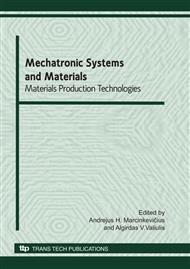[1]
C.T. Kwok, H.C. Man, F.T. Cheng: Scripta Mater. Vol. 39 (1998), pp.1229-1236.
Google Scholar
[2]
S.K. Wu, H.C. Lin, C.H. Yeh: Wear Vol. 244 (2000), pp.85-93.
Google Scholar
[3]
R.E. Apfel: Journal of the Acoustical Society of America Vol. 101(3) (1997), pp.1227-1237.
Google Scholar
[4]
J.M. Pestman, J.B.F.N. Engberts, F. Dejong: Journal of the Royal Netherlands Chemical Society Vol. 113(12) (1994), pp.533-542.
Google Scholar
[5]
W. Lauterborn, C.D. Ohl: Applied Scientific Research Vol. 58(1-4) (1998), pp.63-76.
Google Scholar
[6]
V. Abramov, O. Abramov, V. Bulgakov, F. Sommer: Mat. Letters Vol. 37 (1998), pp.27-34.
Google Scholar
[7]
K.A.J. Borthwick, W.T. Coakley, M.B. McDonnell, H. Nowotny, E. Benes, M. Gröschl: Journal of Microbiological Methods Vol. 60 (2) (2005), pp.207-216.
DOI: 10.1016/j.mimet.2004.09.012
Google Scholar
[8]
M. Romdhane, C. Gourdon, G. Casamatta: Ultrasonics Vol. 34 (1996), pp.835-845.
DOI: 10.1016/s0041-624x(96)00057-1
Google Scholar
[9]
B. Pugin: Ultrasonics Vol. 25 (1987), pp.49-55.
Google Scholar
[10]
I.P. Marangopoulos, C.J. Martin, J.M.S. Hutchinson: Phys. Med. Biol. Vol. 40 (1995), p.18971908.
Google Scholar
[11]
B. Zeqiri, M. Hodnett, A.J. Carroll: Ultrasonics Vol. 44(1) (2006), pp.73-82.
Google Scholar
[12]
E. Maisonhaute, F. Javier Del Campo, R.G. Compton.: Ultrasonics Sonochemistry Vol. 9(5) (2002), pp.275-283.
Google Scholar
[13]
M.A. Margulis: Sonochemical Reactions and Sonoluminescence. In: M. Chimia (Ed. ), 1986, p.286 (in Russian).
Google Scholar
[14]
M.A. Margulis: Sonochemistry and Cavitation. (Gordon & Breach, London 1996).
Google Scholar
[15]
I.R. Jones, D.H. Edwards: J. Fluid Mech. Vol. 7 (1960), p.569.
Google Scholar
[16]
J. Kirejczyk: The energy flux of cavitating flow. Proc. 6th Int. Conf. On fluid Machinery. Budapest, 1979, p.555.
Google Scholar
[17]
X. Chen, R.Q. Xu, Z.H. Shen, J. Lu, X.W. Ni: Optics and Laser Techn. Vol. 36(3) (2004), p.197203.
Google Scholar
[18]
M. Dular, B. Bachert, B. Stoffel, B. Širok: Wear Vol. 257(11) (2004), pp.1176-1184.
DOI: 10.1016/j.wear.2004.08.004
Google Scholar
[19]
K. Steller, T. Krzysztofowicz, Z. Reyman: ASTM Special Tech. Pub. Vol. 567 (1975), p.152.
Google Scholar
[20]
B. Belahadji, J.P. Franc, J.M. Michel: Trans. ASME J. Fluid Eng. Vol. 113 (1991), p.700.
Google Scholar
[21]
G. B Jiang, Y.K. Zheng, Y.Y. Yang, H.S. Fang: Wear Vol. 215 (1998), pp.46-53.
Google Scholar


